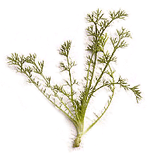
German Chamomile
Introduction
This fact sheet provides basic information about the herb plant or part of a plant used for its flavor, scent, or potential therapeutic properties. Includes flowers, leaves, bark, fruit, seeds, stems, and roots. chamomile-common names, uses, potential side effects, and resources for more information. Two types of chamomile are used for health conditions: German chamomile and Roman chamomile. While the two kinds are thought to have similar effects on the body, the German variety is more commonly used in the United States and is the focus of this fact sheet.Common Names
chamomile, German chamomileLatin Names
Matricaria recutita, Chamomilla recutitaWhat It Is Used For
- Chamomile has been widely used in children and adults for thousands of years for a variety of health conditions.
- The herb is often used for sleeplessness; anxiety; and gastrointestinal conditions such as upset stomach, gas, and diarrhea.
- It is used topically for skin conditions and for mouth ulcers resulting from cancer treatment.
How It Is Used
The flowering tops of the chamomile plant are used to make teas, liquid extracts, capsules, or tablets. The herb can also be applied to the skin as a cream or an ointment, or used as a mouth rinse.What the Science Says
- Chamomile has not been well studied in people so there is little evidence to support its use for any condition.
- Some early studies point to chamomile's possible benefits for mouth ulcers and certain skin conditions. In combination with other herbs, it may be of some benefit for upset stomach and for diarrhea in children.
- NCCAM-funded research on chamomile includes studies of the herb for generalized anxiety disorder and for chronic pain caused by children's bowel disorders.
Side Effects and Cautions
- There are reports of rare allergic reactions in people who have eaten or come into contact with chamomile products. Reactions include skin rashes, throat swelling, shortness of breath, and anaphylaxis (a life-threatening allergic reaction).
- People are more likely to experience allergic reactions to chamomile if they are allergic to related plants in the daisy family, which includes ragweed, chrysanthemums, marigolds, and daisies.
- Tell your health care providers about any complementary and alternative practices you use. Give them a full picture of what you do to manage your health. This helps to ensure coordinated and safe care.
Sources
- German chamomile. Natural Medicines Comprehensive Database Web site. Accessed on May 15, 2007.
- Chamomile (Matricaria recutita, Chamaemelum nobile). Natural Standard Database Web site. Accessed on May 16, 2007.
- Chamomile flower, German. In: Blumenthal M, Goldberg A, Brinckman J, eds. Herbal Medicine: Expanded Commission E Monographs. Newton, MA: Lippincott Williams & Wilkins; 2000:57-61.
- NCCAM National Institutes of Health






